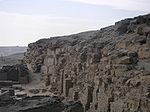
Pyramid of Neferefre
Encyclopedia


Pharaoh
Pharaoh is a title used in many modern discussions of the ancient Egyptian rulers of all periods. The title originates in the term "pr-aa" which means "great house" and describes the royal palace...
Neferefre
Neferefre
Neferefre was a Pharaoh of Egypt during the Fifth dynasty. His name means "Beautiful is Re" in Egyptian.-Family:Neferefre was the son of king Neferirkare Kakai by queen Khentkaus II, and the elder brother of pharaoh Nyuserre Ini....
(or Raneferef) is located at Abusir
Abusir
Abusir is the name given to an Egyptian archaeological locality – specifically, an extensive necropolis of the Old Kingdom period, together with later additions – in the vicinity of the modern capital Cairo...
, Egypt
Egypt
Egypt , officially the Arab Republic of Egypt, Arabic: , is a country mainly in North Africa, with the Sinai Peninsula forming a land bridge in Southwest Asia. Egypt is thus a transcontinental country, and a major power in Africa, the Mediterranean Basin, the Middle East and the Muslim world...
. It was constructed in the Fifth dynasty of Egypt
Fifth dynasty of Egypt
The fifth dynasty of ancient Egypt is often combined with Dynasties III, IV and VI under the group title the Old Kingdom. Dynasty V dates approximately from 2494 to 2345 BC.-Rulers:...
but never completed. Due to its unfinished state and lack of limestone casing the pyramid
Egyptian pyramids
The Egyptian pyramids are ancient pyramid-shaped masonry structures located in Egypt.There are 138 pyramids discovered in Egypt as of 2008. Most were built as tombs for the country's Pharaohs and their consorts during the Old and Middle Kingdom periods.The earliest known Egyptian pyramids are found...
was never plundered as extensively as many other pyramids, and so is one of the best sources for information on how pyramids of this time were constructed. Its formal name was The Pyramid which is divine of the Ba spirits, Divine is Neferefre's power.
Construction
The pyramid was built with sides of 65 metres (213.3 ft) in length and an unknown slope. When the king died, the unfinished pyramid was converted to a giant square mastabaMastaba
A mastaba, or "pr-djt" , is a type of ancient Egyptian tomb in the form of a flat-roofed, rectangular structure with outward sloping sides that marked the burial site of many eminent Egyptians of Egypt's ancient period...
with a slope of 78°. The mortuary temple was rapidly built with mudbrick rather than the typical limestone. The eastern side of the temple was lined with cult chapels and a structure known in Egyptian documents as the Sanctuary of the Knife which was used for animal sacrifice.
Excavations
The pyramid was explored by many early egyptologists including John Perring, Karl Lepsius, Jacques Morgan, and Ludwig BorchardtLudwig Borchardt
Ludwig Borchardt was a German Egyptologist who was born in Berlin.-Life:Borchardt initially studied Architecture and later Egyptology under Adolf Erman. In 1895 he journeyed to Cairo and produced, with Gaston Maspero, the Catalogue of the Egyptian Museum...
, many of whom incorrectly attributed the pyramid to Shepseskare. Due to the structure's unfinished status, none of them believed that it contained the Pharaoh's actual mummy
Mummy
A mummy is a body, human or animal, whose skin and organs have been preserved by either intentional or incidental exposure to chemicals, extreme coldness , very low humidity, or lack of air when bodies are submerged in bogs, so that the recovered body will not decay further if kept in cool and dry...
. Borchardt came within inches of discovering this fact when he carried out a series of exploratory digs in the area, but he quit less than one meter from the pyramid's substructure. Had he continued digging he would have encountered a red sandstone block forming the portcullis to the burial chamber; instead he walked away believing that the pyramid was nothing more than a rough unfinished foundation. His findings consigned the site to over seventy years of archaeological inactivity.
In the 1970s a comprehensive exploration of the site was commissioned by the University of Prague
Charles University in Prague
Charles University in Prague is the oldest and largest university in the Czech Republic. Founded in 1348, it was the first university in Central Europe and is also considered the earliest German university...
, who confirmed that the pyramid did in fact belong to Neferefre and discovered that he had actually been interred in the incomplete structure. The substructure of the temple was found to have been plundered, yielding only broken canopic jars and fragments of the mummy; however, ruins of the mortuary temple provided part of the Abusir Papyri
Abusir Papyri
The Abusir Papyri are the largest papyrus findings to date from the Old Kingdom in Ancient Egypt. The first papyri were discovered in 1893 at Abu Gorab near Abusir in northern Egypt. Their origins are dated to around the 24th century BC during the Fifth dynasty of Egypt, making them, even though...
, statuary, stone vessels, mud seals, and faience
Faience
Faience or faïence is the conventional name in English for fine tin-glazed pottery on a delicate pale buff earthenware body, originally associated with Faenza in northern Italy. The invention of a white pottery glaze suitable for painted decoration, by the addition of an oxide of tin to the slip...
inlays for study.

